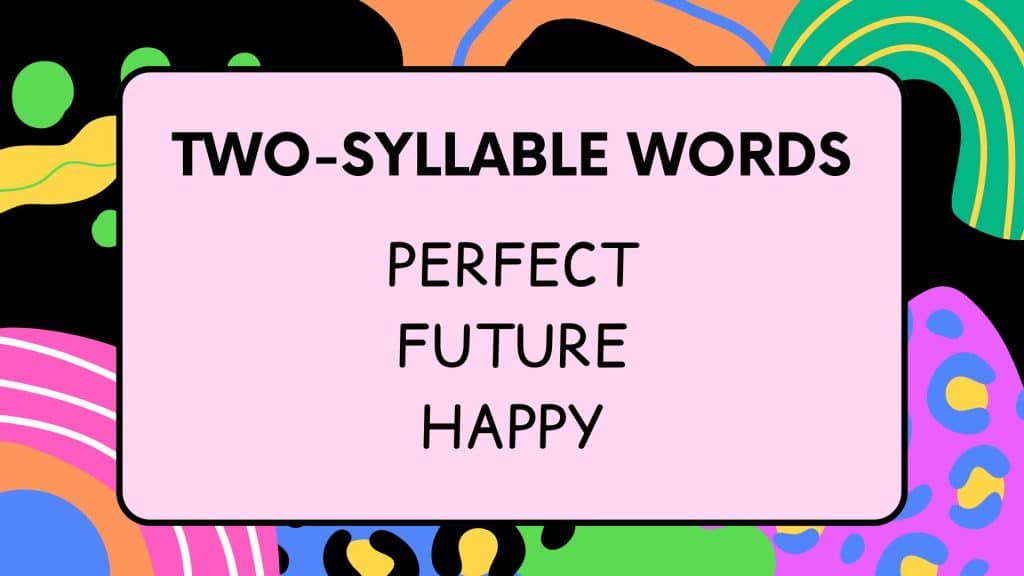Have you ever felt your writing lacks rhythm?
Many writers struggle to make their words flow smoothly, leaving readers unengaged.
But there’s a simple secret: two-syllable words.
These powerful tools can transform your writing, adding musicality to poetry and prose.
In this guide, we’ll explore how to use two-syllable words effectively.
You’ll learn to create rhythm, enhance your style, and captivate your audience.
By the end, you’ll have the skills to make your writing more dynamic and engaging.
Ready to give your words a rhythmic boost? Let’s begin
Understanding Two-Syllable Words

| Word Type | Example Sentence | Effect on Rhythm and Pace |
|---|---|---|
| One-Syllable | “The light glints off the stream.” | Quick, sharp rhythm; feels brisk and staccato, conveying a straightforward narrative pace. |
| Two-Syllable | “Gentle breezes stir the leaves.” | Smooth and balanced, it slows down the pace slightly, giving the sentence a lyrical, flowing quality. |
| Three-Syllable | “Serenity envelops the tranquil scene.” | A slower, more complex rhythm creates a languid pace, allowing deeper reflection and a richer narrative texture. |
Two-syllable words are fundamental building blocks of language that add depth, rhythm, and nuance to writing. When spoken, they consist of two distinct sound units or beats, creating a balanced cadence in text.
Some common examples include:
- “Wonder”
- “Gentle”
- “Shining”
These words offer a middle ground between short, snappy, one-syllable words and longer, more complex terms.
They provide a smooth reading experience without making the text too simple or heavy.
By incorporating two-syllable words, writers can create a more engaging and varied linguistic landscape.
Two-syllable words also contribute to the overall flow and pacing of a piece:
- They can be used to control the speed at which readers process information
- They allow for moments of emphasis or reflection within the text
This control over pacing can be particularly useful in narrative writing, where the rhythm of the prose can enhance the storytelling.
In addition, two-syllable words often carry more specific meanings than their one-syllable counterparts. For example:
- “Water” is a broad term
- “River,” “ocean,” and “rainfall” all convey more precise images
This specificity can help writers create more vivid and accurate descriptions.
Balancing Simplicity and Complexity
Two-syllable words strike a perfect balance in writing.
- They’re not as basic as one-syllable words, yet they’re easier to grasp than longer terms.
- This balance allows writers to express ideas clearly while maintaining a pleasing flow in their work.
By using these words, authors can create text that’s both rich in meaning and easy to read. This balance is key in keeping readers engaged without overwhelming them.
Two-syllable words offer enough complexity to convey sophisticated ideas yet remain accessible to many readers.
Moreover, these words can bridge between simpler and more complex concepts, helping readers transition smoothly through different levels of understanding within a text.
This versatility makes two-syllable words invaluable tools for writers across various genres and styles.
Using two-syllable words can also contribute to a piece’s tone and style. For instance:
- In formal writing, two-syllable words can add sophistication without becoming overly academic.
- In casual writing, they can provide variety and interest without sounding pretentious.
Two-Syllable Words: The Role of Rhythm and Cadence
Two-syllable words play a vital part in creating rhythm in writing.
- They act like musical notes, adding a steady beat to sentences and paragraphs.
- This rhythm makes reading more enjoyable and helps ideas flow smoothly from one to the next.
In poetry, these words fit well into various meters.
- They can form the backbone of iambic or trochaic lines.
- In prose, they help create a natural, speech-like cadence that pulls readers along.
Using two-syllable words can also help writers control the pace of their narrative, speeding up or slowing down the reader’s progress through the text as needed.
Furthermore, these words can create patterns and repetitions that enhance a piece’s musicality.
By strategically placing two-syllable words throughout a text, writers can create a subtle underlying rhythm that keeps readers engaged and makes the writing more memorable.
The rhythm created by two-syllable words can also emphasize key points or create a sense of momentum.
For example, a series of two-syllable words can build up to a pivotal moment in a story or drive home an important argument in an essay.
Meter and Beat
In poetry, two-syllable words often form the core of metrical feet.
For instance:
- Words like “delight” or “return” fit perfectly in the iambic meter.
- In trochaic meter, words such as “gently” or “swiftly” work well.
In prose, these words help vary sentence rhythm.
- They can break up strings of one-syllable words or provide a pause between longer terms.
- This variety keeps the writing from becoming monotonous.
Two-syllable words can also emphasize a sentence, drawing the reader’s attention to key ideas or images.
Additionally, the strategic use of two-syllable words can help writers control the emotional tone of their work.
By choosing words with different stress patterns, writers can create a sense of urgency, calm, or tension to support their narrative or thematic goals.
Understanding how to manipulate meter and beat using two-syllable words can greatly enhance a writer’s ability to create mood and atmosphere. For example:
- A preponderance of iambic two-syllable words can create a sense of forward motion
- Trochaic words might evoke a more measured, thoughtful pace
Enhancing Imagery and Emotion
The two-syllable words in the poem—glowing, buzzing, heartbreak, joyful, and somber—enhance its imagery and emotional impact in several ways:
- Rhythm and Flow: These words create a natural, engaging rhythm emphasizing key moments.
- Sensory Details: Words like glowing and buzzing evoke strong visual and auditory imagery, immersing readers in the scene.
- Emotional Depth: Terms like heartbreak, joyful, and somber convey deep emotions succinctly, making them resonate strongly.
- Contrast and Balance: The juxtaposition of somber and joyful highlights emotional duality, adding complexity and depth to the poem.
Two-syllable words can paint vivid pictures in readers’ minds.
- Words like “shimmering,” “glowing,” or “buzzing” bring scenes to life more vividly than simpler alternatives.
- They allow writers to pack more detail into fewer words.
These words also carry strong emotional weight.
- Terms like “heartbreak,” “joyful,” or “somber” convey feelings more intensely than their one-syllable counterparts.
- This emotional depth helps readers connect more strongly with the text.
Using two-syllable words can create a more immersive reading experience, allowing readers to engage fully with the text’s world.
Moreover, two-syllable words often have onomatopoeic qualities, meaning their sound can reinforce their meaning.
This can further enhance the sensory experience for readers, making the writing more impactful and memorable.
Emotional Impact
Using two-syllable words can greatly affect how readers feel about a piece of writing. These words often carry nuanced meanings that can stir specific emotions.
For example:
- “Whisper” creates a sense of intimacy
- “Thunder” evokes power and awe
By carefully choosing these words, writers can guide readers’ emotional responses. This ability to evoke feelings makes the writing more engaging and memorable.
Two-syllable words can also help create a consistent emotional tone throughout a piece, reinforcing the overall mood or theme.
Furthermore, the rhythmic quality of two-syllable words can contribute to emotional impact:
- The rise and fall of stressed and unstressed syllables can mirror emotional states
- This subtly influences the reader’s perception and response to the text
Practical Techniques for Writers
To use two-syllable words effectively, mix them with words of different lengths.
This mixing creates a varied rhythm that keeps readers interested.
For example, combine short, punchy words with two-syllable terms and longer phrases.
It’s also important to choose two-syllable words that fit the context and tone of your writing.
Select words that match the emotion you want to convey and the style of your piece.
Consider the overall sound of your sentences and paragraphs, using two-syllable words to create pleasing rhythms and avoid monotony.
- Experiment with placing two-syllable words at different points in your sentences to see how they affect the flow and emphasis.
- Notice how these words interact with surrounding words to create the desired effect.
Contextual Use of Two-Syllable Words
When picking two-syllable words, consider the overall mood of your writing.
- Words like “bubbly” or “cheerful” work well for a lighthearted piece.
- For more serious topics, terms like “solemn” or “weighty” might be more fitting.
Also, think about how these words sound when read aloud:
- Some two-syllable words flow smoothly, while others create emphasis.
- Choose based on the effect you want to achieve in your writing.
- Consider the pacing of your piece and how two-syllable words can help control that pace.
Remember that context is key.
A word that works well in one situation might feel out of place in another.
Consider how your chosen words fit into the larger picture of your writing.
Wrapping Up
Mastering two-syllable words can transform your writing.
These powerful tools add rhythm, depth, and emotion to your work, perfectly balancing simplicity and complexity.
So, what’s next?
Start experimenting! Replace single-syllable words with two-syllable options in your next piece.
Notice how it changes the flow and impact of your text.
Remember, the goal is to find your unique voice.
You’ll develop a natural style that resonates with readers as you practice.
Challenge yourself to use two-syllable words in new ways.
The more you experiment, the more skilled you’ll become.
Ready to elevate your writing?
Begin your two-syllable exploration today.









One Comment
pin-up: pin-up – pin-up